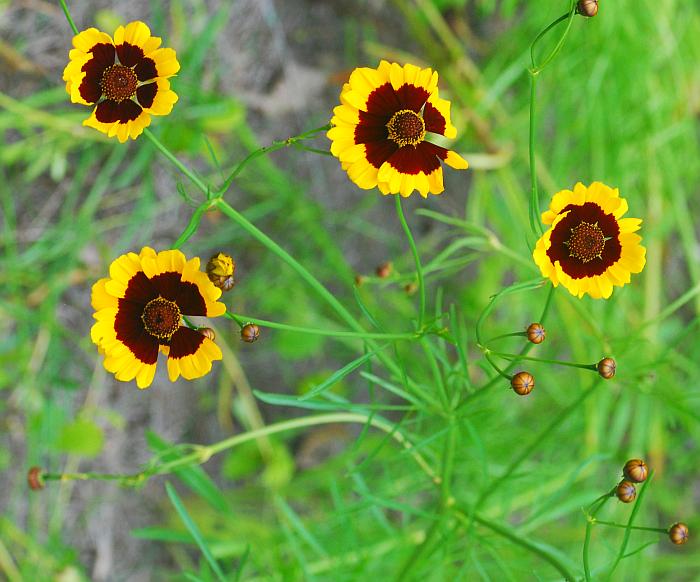Coreopsis tinctoria Nutt.
Plains Coreopsis

Native
CC = 1
CW = 0
MOC = 30
© SRTurner
Coreopsis tinctoria Nutt.Plains Coreopsis | |
 |
Native CC = 1 CW = 0 MOC = 30 |
© SRTurner |
|
Family - Asteraceae/Heliantheae Habit - Taprooted annual forb. Stems - Ascending to erect, to 1.2 m, typically single from base, branching above, glabrous.
Leaves - Opposite, compound, sessile or short-petiolate, distributed at 6-12 nodes along most of the stem length. Leaf blades 1.5-10.0 cm long, oblong to elliptic or obovate in outline, 1 or 2 times pinnately dissected, the mostly 5-25 ultimate segments 1-4 mm wide, narrowly linear to linear-lanceolate, usually somewhat tapered at the base and tip, the surfaces glabrous. Petioles and petiolules with some pubescence. Petioles to 8 cm long. Upper leaves larger than lower.
Inflorescence - Appearing as panicles, the heads with the stalk mostly 2-5 cm long. Heads - Radiate, showy. Involucre often reddish-tinged, the bracts dimorphic, the outer series 1-4 mm long; the inner series 4-9 mm long. Chaffy bracts linear, not widened at the base or tip.
Ray flowers - Typically 8 per head, sterile, the corollas 12-20 mm long, with 3-4 deep, sometimes irregular or jagged teeth or lobes around the tip, yellow with a well-differentiated region of deep reddish toward the base, occasionally all red. Disk flowers - Perfect, the corollas 2.5-3.5 mm long, mostly 4-lobed, reddish purple, sometimes with a yellow tube. Style branches with a short, bluntly pointed, sterile tip. Pappus absent or of 1 or 2 teeth or awns to 1.5 mm long.
Fruits - Achenes 1.5-3.0 mm long, the base and tip appearing curled or arched inward at maturity, the angles usually with narrow to broad, pale wings having entire to slightly irregular margins, the inner face slightly thickened at 1 or both ends, dark brown to black, 1 or both surfaces usually with numerous small, lighter-colored tubercles. Flowering - June - September. Habitat - Glades, fields, roadsides, railroads, often in sandy substrate. Origin - Native to the U.S. Lookalikes - Sometimes, young specimens of Ratibida columnifera. Other info. - This attractive species is found in scattered locations across most of Missouri, and in a similar scattered fashion across most of the continental U.S. In many states it is considered a waif, appearing only sporadically and not persisting. When in flower it is easy to ID, due to the unusual and striking two-colored ray corollas. Most populations will also have at least a few flowering heads that are entirely deep red. These color variants have been assigned as forms in the past. Note that Ratibida columnifera can also have bicolor rays, but the flowering heads of that species normally have greatly elongated receptacles. Photographs taken in Springfield, MO., 7-5-03, and somewhere in Alabama, 6-20-04 (DETenaglia); also at Shaw Nature Reserve, Franklin County, MO, 6-27-2008, Busch Greenway / Duckett Creek, St. Charles County, MO, 6-20-2009, and near Gray Summit, Franklin County, MO, 7-5-2015 (SRTurner). |